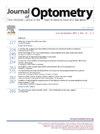Evaluation of the repeatability of corneal epithelial thickness mapping in healthy and keratoconic eyes with two spectral domain optical coherence tomography
IF 1.8
Q2 OPHTHALMOLOGY
引用次数: 0
Abstract
Purpose
To evaluate the repeatability of corneal epithelial thickness measurements using anterior segment optical coherence tomography (AS-OCT) and a posterior segment OCT adapted with an anterior module, in subjects with keratoconus and healthy controls.
Methods
A spectral domain AS-OCT (MS-39) and a posterior segment OCT (HS-100) with ASA-1 adaptor were used to measure the corneal epithelial thickness in healthy and keratoconic eyes. Three measurements per participant were taken, and the repeatability was described using the repeatability limit (Rlim), calculated from the within-subject standard deviation.
Results
81 eyes of 81 controls and 80 eyes of 52 keratoconus subjects (43 % cross-linking, and 13 % contact lens users) were included. For the MS-39, the central sector showed the best repeatability for both groups, with Rlim never exceeding 5 μm in any sector. For the HS-100, the best repeatability was obtained for the central sector, with the Rlim never exceeding 7 μm in any of the sectors for the control group and all but one (outer-inferior) in the keratoconus group. The Rlim for the keratoconus group varied <1 μm between contact users/non-users or between eyes with/without a history of CXL. Differences in Rlim were larger than 2 μm in the peripheral horizontal sectors between each sub-group with the HS-100.
Conclusions
Both OCTs showed good epithelial thickness measurement repeatability in all groups, though the repeatability of the HS-100 was mildly lower for keratoconic eyes. Contact lens use and crosslinking history did not affect repeatability. These OCTs effectively measure epithelial thickness in keratoconus patients, which could be helpful in monitoring keratoconus progression.
用双光谱域光学相干断层扫描评价健康和角膜锥形眼角膜上皮厚度制图的可重复性
目的评价前段光学相干断层扫描(AS-OCT)和后段光学相干断层扫描(AS-OCT)对圆锥角膜患者和健康对照者角膜上皮厚度测量的可重复性。方法采用sa谱域AS-OCT (MS-39)和带ASA-1接头的后段OCT (HS-100)分别测量健康眼和角膜闭合眼的角膜上皮厚度。每位受试者进行了三次测量,使用重复性极限(Rlim)描述重复性,从受试者内标准差计算。结果纳入对照组81只眼和52只圆锥角膜患者80只眼,其中交联者43% ,隐形眼镜使用者13% 。对于MS-39,两组的中央扇区均表现出最佳的重复性,任何扇区的Rlim均未超过5 μm。对于HS-100,中央扇区获得了最好的重复性,对照组的任何扇区的Rlim均未超过7 μm,圆锥角膜组的Rlim均未超过7 μm。圆锥角膜组的Rlim在接触者/非接触者或有/没有CXL病史的眼睛之间变化了<;1 μm。各亚组与HS-100在周边水平扇区的Rlim差异均大于2 μm。结论两组oct均显示出良好的上皮厚度测量重复性,但HS-100在角膜锥形眼的重复性略低。使用隐形眼镜和交联历史不影响可重复性。这些oct能有效测量圆锥角膜患者的上皮厚度,有助于监测圆锥角膜的进展。
本文章由计算机程序翻译,如有差异,请以英文原文为准。
求助全文
约1分钟内获得全文
求助全文

 求助内容:
求助内容: 应助结果提醒方式:
应助结果提醒方式:


